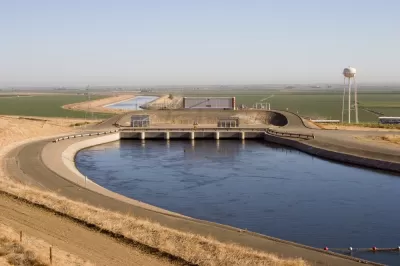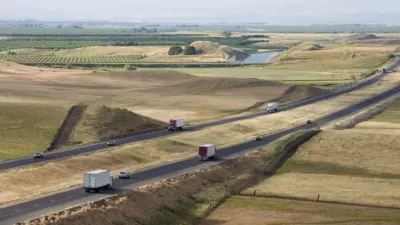After a wet winter, California's historic drought is over for now. But larger stores of groundwater stored in natural aquifers, steadily depleting, will be difficult to refill.

California's past winter was a lot wetter than the last few, replenishing reservoirs and snowpack in a drought-afflicted state. "Thomas Harter, a professor with the [University of California, Davis] Department of Land, Air and Water Resources, says the rainy winter will make a dent in the state's groundwater deficit, especially for the Central Valley."
However, Alastair Bland reports, groundwater levels are still declining over the long term and it's hard to refill deep aquifers. "The challenge, then, will be for Californians to identify methods for diverting surplus surface water during wet winters into areas where it can sink into the ground and recharge overdrawn aquifers."
These groundwater reserves are much larger than the total volume of snowpack and reservoirs. But last winter, a lot of precipitation drained into the ocean rather than the aquifers (which can collapse when they're overdrawn, permanently reducing capacity). Harter says the best way to refill them would be to let surplus flows drain through agricultural lands.
FULL STORY: How Wet Weather Impacted California’s Groundwater Deficit

Study: Maui’s Plan to Convert Vacation Rentals to Long-Term Housing Could Cause Nearly $1 Billion Economic Loss
The plan would reduce visitor accommodation by 25,% resulting in 1,900 jobs lost.

North Texas Transit Leaders Tout Benefits of TOD for Growing Region
At a summit focused on transit-oriented development, policymakers discussed how North Texas’ expanded light rail system can serve as a tool for economic growth.

Why Should We Subsidize Public Transportation?
Many public transit agencies face financial stress due to rising costs, declining fare revenue, and declining subsidies. Transit advocates must provide a strong business case for increasing public transit funding.

How to Make US Trains Faster
Changes to boarding platforms and a switch to electric trains could improve U.S. passenger rail service without the added cost of high-speed rail.

Columbia’s Revitalized ‘Loop’ Is a Hub for Local Entrepreneurs
A focus on small businesses is helping a commercial corridor in Columbia, Missouri thrive.

Invasive Insect Threatens Minnesota’s Ash Forests
The Emerald Ash Borer is a rapidly spreading invasive pest threatening Minnesota’s ash trees, and homeowners are encouraged to plant diverse replacement species, avoid moving ash firewood, and monitor for signs of infestation.
Urban Design for Planners 1: Software Tools
This six-course series explores essential urban design concepts using open source software and equips planners with the tools they need to participate fully in the urban design process.
Planning for Universal Design
Learn the tools for implementing Universal Design in planning regulations.
City of Santa Clarita
Ascent Environmental
Institute for Housing and Urban Development Studies (IHS)
City of Grandview
Harvard GSD Executive Education
Toledo-Lucas County Plan Commissions
Salt Lake City
NYU Wagner Graduate School of Public Service




























